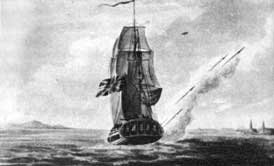
Rocket vessel
Encyclopedia

Rocket
A rocket is a missile, spacecraft, aircraft or other vehicle which obtains thrust from a rocket engine. In all rockets, the exhaust is formed entirely from propellants carried within the rocket before use. Rocket engines work by action and reaction...
s as a weapon. The most famous ship of this type was HMS Erebus
HMS Erebus (1807)
HMS Erebus was originally built as a Royal Navy fireship, but served as a sloop and was re-rated as such in March 1808. She served in the Baltic during the Gunboat and Anglo-Russian Wars, where in 1809 she was briefly converted to a fireship, and then served in the War of 1812. In 1814 she was...
, which at the Battle of Baltimore
Battle of Baltimore
The Battle of Baltimore was a combined sea/land battle fought between British and American forces in the War of 1812. It was one of the turning points of the war as American forces repulsed sea and land invasions of the busy port city of Baltimore, Maryland, and killed the commander of the invading...
in 1814 provided the "rockets' red glare" that was memorialized by Francis Scott Key
Francis Scott Key
Francis Scott Key was an American lawyer, author, and amateur poet, from Georgetown, who wrote the lyrics to the United States' national anthem, "The Star-Spangled Banner".-Life:...
in The Star-Spangled Banner
The Star-Spangled Banner
"The Star-Spangled Banner" is the national anthem of the United States of America. The lyrics come from "Defence of Fort McHenry", a poem written in 1814 by the 35-year-old lawyer and amateur poet, Francis Scott Key, after witnessing the bombardment of Fort McHenry by the British Royal Navy ships...
.
Rocket vessels were also used by the Royal Navy
Royal Navy
The Royal Navy is the naval warfare service branch of the British Armed Forces. Founded in the 16th century, it is the oldest service branch and is known as the Senior Service...
in the attack on the French fleet at Boulogne-sur-Mer
Boulogne-sur-Mer
-Road:* Metropolitan bus services are operated by the TCRB* Coach services to Calais and Dunkerque* A16 motorway-Rail:* The main railway station is Gare de Boulogne-Ville and located in the south of the city....
in 1806 and at the second Battle of Copenhagen
Battle of Copenhagen (1807)
The Second Battle of Copenhagen was a British preemptive attack on Copenhagen, targeting the civilian population in order to seize the Dano-Norwegian fleet and in turn originate the term to Copenhagenize.-Background:Despite the defeat and loss of many ships in the first Battle of Copenhagen in...
in 1807. At the Battle of the Basque Roads
Battle of the Basque Roads
The Battle of the Basque Roads, also Battle of Aix Roads was a naval battle during the Napoleonic Wars off the Island of Aix...
in 1809, there were no less than three vessels participating that had been fitted to throw rockets: two hired armed cutters King George and Nimrod
Hired armed cutter Nimrod
During the French Revolutionary and Napoleonic Wars the Admiralty also made use of hired armed vessels, one of which was the hired armed cutter Nimrod. Three such vessels are recorded, but the descriptions of these vessels and the dates of their service are such that they may well represent one...
, and the schooner Whiting
HMS Whiting (1805)
HMS Whiting was a Royal Navy Ballahoo-class schooner of four 12-pounder carronades and a crew of 20. The prime contractor for the vessel was Goodrich & Co., in Bermuda, and she was launched in 1805...
.
The Congreve rocket
Congreve rocket
The Congreve Rocket was a British military weapon designed and developed by Sir William Congreve in 1804.The rocket was developed by the British Royal Arsenal following the experiences of the Second, Third and Fourth Mysore Wars. The wars fought between the British East India Company and the...
s of this period were highly inaccurate and unreliable, and were primarily used as a psychological weapon of terror in conjunction with other, more effective, weapons, such as mortar shells thrown by bomb vessel
Bomb vessel
A bomb vessel, bomb ship, bomb ketch, or simply bomb was a type of wooden sailing naval ship. Its primary armament was not cannon —although bomb vessels carried a few cannon for self-defence—but rather mortars mounted forward near the bow and elevated to a high angle, and projecting their fire in a...
s.
The Erebus
HMS Erebus (1807)
HMS Erebus was originally built as a Royal Navy fireship, but served as a sloop and was re-rated as such in March 1808. She served in the Baltic during the Gunboat and Anglo-Russian Wars, where in 1809 she was briefly converted to a fireship, and then served in the War of 1812. In 1814 she was...
was equipped with a 32-pound rocket battery installed below the main deck, which fired through portholes or scuttles pierced in the ship's side. Some of the other rocket vessels used by the Royal Navy
Royal Navy
The Royal Navy is the naval warfare service branch of the British Armed Forces. Founded in the 16th century, it is the oldest service branch and is known as the Senior Service...
were small boats, rather than ships. These carried a rocket launcher frame supported by a mast and raised and lowered by means of halyard
Halyard
In sailing, a halyard or halliard is a line that is used to hoist a sail, a flag or a yard. The term halyard comes from the phrase, 'to haul yards'...
s.
Modern warships carry a variety of rocket-powered missile
Missile
Though a missile may be any thrown or launched object, it colloquially almost always refers to a self-propelled guided weapon system.-Etymology:The word missile comes from the Latin verb mittere, meaning "to send"...
weapons.

